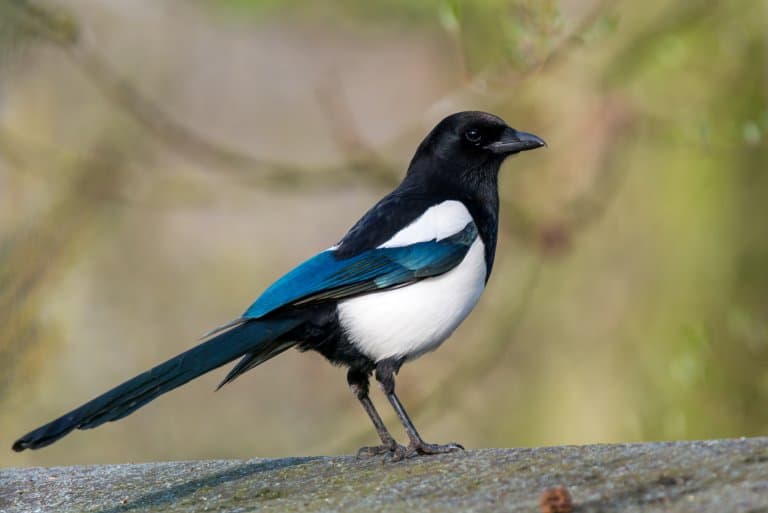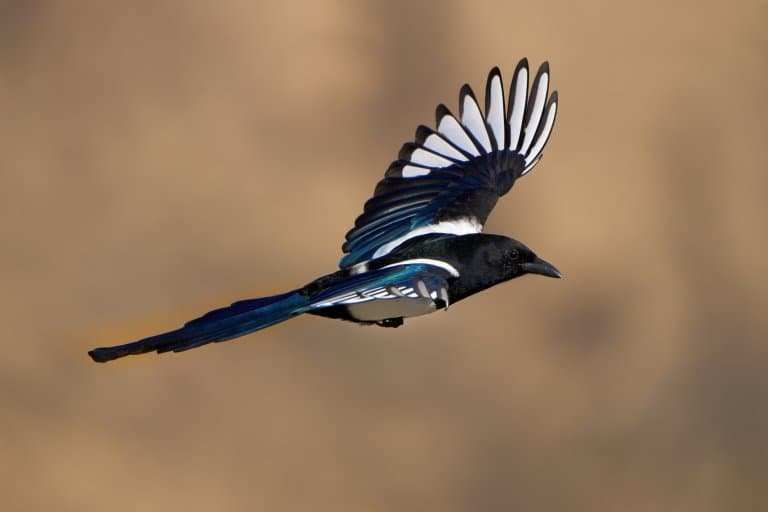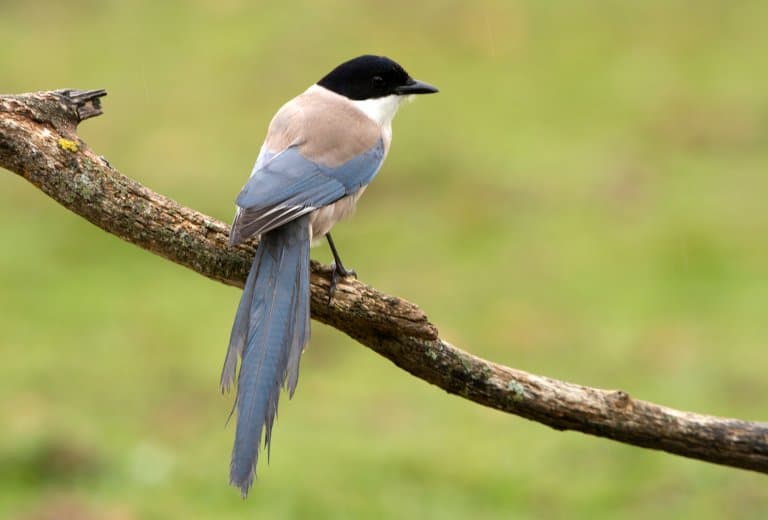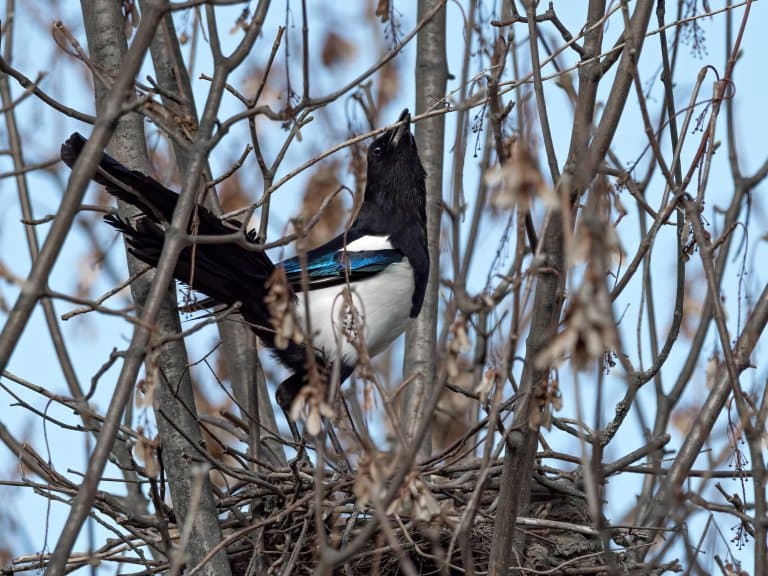Magpie Profile
No bird family occupies more of a place in folklore and literature than the Corvids. They’re the subject of Edgar Allen Poe narratives, local tales of witchcraft, ominous residents of medieval prisons, and age-old children’s nursery rhymes.
They’re a symbol of both dark superstition and reverence. And while crows and ravens hold much of the spotlight, the striking and intelligent magpie more than pulls its weight in this regard.

Magpie Facts Overview
| Habitat: | Cosmopolitan, with a preference for wild areas |
| Location: | Europe, North America, Asia, |
| Lifespan: | Up to 30 years |
| Size: | Up to 65cm (25 inches) wingspan |
| Weight: | Up to around 250g (0.6lb) |
| Colour: | Black and white |
| Diet: | Omnivorous |
| Predators: | Cats, dogs, foxes, mustelids, raptors |
| Top Speed: | 50km/h (31 mph) |
| No. of Species: | Around 18 |
| Conservation Status: | Least Concern to Critically Endangered (Javan green magpie, IUCN) |
Magpies are not a single grouping of birds, in fact, the common name extends well beyond the bird class. The classic orca-like pattern isn’t present in all true magpies, but many other traits are.
They’re particularly smart, very social, and almost always referred to as a symbol of something bigger than themselves.
In Europe, this is usually a bad thing, in Asia, it’s often good luck. Many species are thriving, but some are in great danger.
Interesting Magpie Facts
1. Their name originates from their tendency to feed on anything
Birds were originally given common names, such as robin (redbreast), or jenny wren.
Magpie, was previously maggie pie as the common name.
‘Pie’ was derived from Latin ‘pica’, which was a human disorder involving a compulsive desire to eat items that are not food – in references to the magpies reputation for eating random, miscellaneous things.

2. They’re not black and white
Magpies aren’t a single species. They’re not even a single genus in many cases, and in some others, they occupy entirely different families. This is a grouping that came about from common language, so it’s not very strong as a taxonomic classification.
The word “magpie” has even been used to describe a species of butterfly, as well as at least four species of moth, a fish, a cat, an Australian rugby team, and various other objects and entities that are very un-birdlike.
But within birds, there are a few groups commonly agreed-upon as magpies, all of which occupy the crow family Corvidae. Even within this family, magpies are very varied and come in multiple shapes and sizes.
There are four genera of magpie corvids. The classic black-and-white mischief that’s the inspiration for countless tales of witchcraft and superstition will be one of the seven magpies that form the Pica genus.
But there are also Asian blue-and-green magpies, thought to bring good luck, small grey and blue magpies from Siberia, and a critically endangered bright green magpie from Indonesia with a red beak and a cute black mask.

3. One for sorrow, two for joy
One of the most common legends about the classic black and white Eurasian magpie is associated with a nursery rhyme that explains the consequences of looking at the wrong number of birds and suggests the number of birds it’s a good idea to see.
“One for sorrow, two for joy, three for a girl, four for a boy…”
This is one version of the superstitious whimsy for which our ancestors are well known. It was even said in some versions that either 7 or 13 magpies represent the devil himself.
In France, magpies were considered to be the reincarnation of evil nuns. In Sweden, they’re a symbol of witchcraft.
Sometimes the rhyme is expanded to refer to any corvid, which seems a bit indecisive, and it was said that in order to relieve yourself of any of the associated curses, either carrying an onion with you or saluting them as you pass by, should do the trick.
This latter recommendation is the only one really worth following, but not out of self-preservation; the magpie is well deserving of the respect. 1
4. They’re incredibly intelligent
There are quite a few ways to consider animal intelligence. One popular one is to look at the size of its brain. But big animals tend to have big brains, so it needs to be balanced against the size of its body, too.
The Eurasian magpie happens to have a similar brain-size-to-bodyweight ratio as chimps and humans at least in the area analogous to the prefrontal cortex.
This nidopallium is essentially responsible for executive function and other complex higher functions. The size of this part of the brain in magpies strongly suggests that they are also capable of complex expressions of intelligence such as biting their own tongues, and getting into fights at football matches.
But this is only one way to assume something is smart. Behavioural testing on magpies has backed up this hypothesis. Object permanence is the concept of understanding that something exists, even though you can’t see it.
The Covid pandemic showed us the human limitations of this concept but magpies probably handled the outbreak quite a lot better. They’ve shown incredible cognitive abilities across numerous tests, including one that showed that their development of object permanence resembles the same time course as that of cats. 2

5. They recognise people
Corvids are well known to be smart, and some magpies might be some of the smartest animals there are. 3
They recognize human faces, which is a lot more than we can do in return, as they all look more or less the same to us.
They also have emotional intelligence and will form strong friendships with one another. But more than this, they even make loyal friends with people, if they’re treated kindly, to the point where they will trust humans around their children. 4
6. They can pass the mirror test
This is a bit of a controversial test of ‘intelligence’ based on the concept of self-awareness.
It’s used to establish whether an animal has enough consciousness and smarts to recognise itself in a mirror, and if it does, the implication is that the animal is therefore somehow smarter than one who can’t.
There are some notoriously bright animals on the list of those who pass this test. At the risk of blowing our own trumpet, humans tend to perform well in this test. As do many human-like animals like chimps and bonobos.
Magpies can identify themselves in a mirror and have been shown using one to find and remove a mark on their face, just as we might use one to remove a bit of spinach from our teeth.
This is a particularly fascinating discovery, as human intelligence evolved along a totally different evolutionary path than avian intelligence, suggesting that it’s a product of convergent evolution.
7. They’re not easy to tell apart
The majority of passerines, that is, the order to which magpies and other perching birds belong, are sexually dimorphic. Most times the male is more vivid or colourful than the female, and in some cases, significantly bigger.
Magpies didn’t get this memo, and both the males and the females are almost identical. So, researchers aren’t able to tell them apart without spending time looking at their behaviours.

8. They’re unfairly persecuted
A lot of farmers will spread the rumour that corvids, including magpies, will peck out a lamb’s eyes.
In rural parts of the world over, it’s always the same tale of protective farmers against competition from birds, and while some of this competition does exist, for the most part, it’s overblown.
There’s little evidence to suggest that magpies have any effect on sheep farming whatsoever, yet the rumours persist, and heated arguments around a farmer’s right to shoot birds are ongoing.
Still, Eurasian magpies are not threatened at present. Sadly, the same can’t be said for some of their cousins. 5
9. Some are in a lot of trouble
While the Eurasian magpie is hugely successful in its immense range (it may have up to 19 million breeding pairs), some species aren’t doing as well.
The Javan Green Magpie is an equally-stunning example of a corvid with a colour scheme in line with its Southeast Asian peers. In contrast with the Eurasian Magpie, this species has only up to 249 breeding pairs, and possibly as few as 50.
These beautiful birds are commonly trapped for the bird trade and sold in roadside markets to feed the huge demand for caged birds in private homes. As you’d expect in Indonesia, they’re also greatly affected by habitat loss from deforestation.
They’re thought to exist in at least three protected national parks, but two of these are still faced with illegal encroachment, and more research is proposed to increase the conservation efforts in the region. 6

10. Magpies don’t steal shiny objects
A popular myth of the Eurasian magpie is that they steal or are attracted to shiny objects. The Collins English Dictionary even defines a magpie as “a person who hoards small objects”.
However, research by Exeter University scientists showed that magpies are actually nervous of such objects. It’s thought that this might be because they are perceived to be dangerous.
Lead author Dr Toni Shephard of the study said:
7“We did not find evidence of an unconditional attraction to shiny objects in magpies. Instead, all objects prompted responses indicating neophobia – fear of new things.
“We suggest that humans notice when magpies occasionally pick up shiny objects because they believe the birds find them attractive, while it goes unnoticed when magpies interact with less eye-catching items. It seems likely that the folklore surrounding them is a result of cultural generalisation and anecdotes rather than evidence.”
Magpie Fact-File Summary
Scientific Classification
| Kingdom: | Animalia |
| Phylum: | Chordata |
| Class: | Aves |
| Order: | Passeriformes |
| Family: | Corvidae |
| Genera: | Pica Urocissa Cissa Cyanopica |
Fact Sources & References
- Ian Morton (2019), “Curious Questions: One for sorrow, two for joy – but why are we so superstitious about magpies?”, Country Life.
- Bettina Pollok (2000), “Development of Object Permanence in Food-Storing Magpies (Pica pica)”, Sci Hub.
- Won Young Lee (2011), “Wild birds recognize individual humans: experiments on magpies, Pica pica”, Springer Link.
- Gisela Kaplan (2017), “Magpies can form friendships with people – here’s how”, The Conversation.
- Richard Godwin (2019), “A murder of crows: Chris Packham and the countryside war over bird killings”, The Guardian.
- “Javan Green Magpie”, IUCN.
- Roger Harrabin (2014), “Magpies ‘don’t steal shiny objects’“, BBC News.
